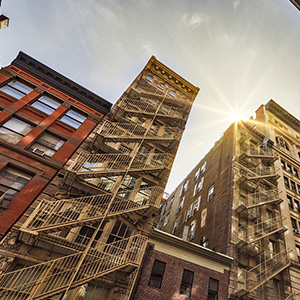NYC Local Law 88: Lighting Upgrades & Sub-Meters in Mixed-Use Residential Buildings
FirstService Energy, our in-house energy management and advisory affiliate, helps boards and building owners reduce energy costs, consumption and carbon emissions – all tied to a myriad of local laws impacting New York City’s built environment.
Contact us today to explore how FirstService Energy and FirstService Residential can enhance your property’s long-term energy performance.
Energy use by non-residential tenants (commercial, community facilities, medical centers, etc.) accounts for a large portion of overall electricity consumption in mixed-use buildings, a behavior pattern that is largely unknown to these tenants. Sub-metering and the adoption of modern lighting technologies is critical to reducing energy consumption by non-residential tenants.
New York City Local Law 88 of 2009, with its subsequent expansions Local Law 132 and Local Law 134, requires most mixed-use residential buildings larger than 25,000 square feet to upgrade lighting in common areas to current NYC energy code, install sub-meters for each non-residential tenant space exceeding 5,000 square feet and provide monthly energy-use statements to sub-metered tenants.
Building owners have until January 1, 2025 to comply, but should begin mapping out a road to compliance to minimize disruption to tenants and residents.
To help boards and building owners understand these new requirements, our experts at FirstService Energy, the trusted energy advisor to FirstService Residential properties, have answered the most commonly asked questions about compliance.
Which properties must comply?
A mixed-use building, referred to as a “covered building” in the law, includes:- Buildings 25,000 square feet or larger
- Two or more buildings that share a tax lot and are together greater than 100,000 square feet
- Two or more buildings held in condominium form of ownership that are governed by the same board and are together more than 100,000 square feet
Areas of the building that are occupied by non-residential tenants are referred to as “covered tenant spaces” in the law, which does not include residential units and amenity spaces, communal areas including lobbies and hallways, or mechanical rooms.
Buildings classified as R-2 and R-3 occupancy types are exempt from Local Law 88. However, exempt buildings, as well as buildings already in compliance with the law, must still file a lighting report with the New York City Department of Buildings (DOB) demonstrating their status and exemption.
What is a sub-meter?
A sub-meter is a device installed within a building’s electrical distribution system that measures the flow of electricity within a defined space and is used to apportion the cost of electricity.When is the best time to install sub-meters?
Sub-meters should be installed on an ongoing basis, space by space, ideally during a commercial tenant’s build out. This approach is typically less expensive for the building.When possible, meter the entire building in one phase. While this may be disruptive to tenants and requires more up-front capital, installing meters in bulk is significantly less expensive in the long-run than proceeding space by space.
What does the law require with regard to sub-metering and monthly electrical use statements?
The law requires sub-meters to be installed in mixed-use buildings prior to January 1, 2025. If the building has one or more floors with multiple non-residential components, the building is required to provide each tenant:- A separate sub-meter
- A shared sub-meter with other tenant spaces on the floor, OR
- A shared sub-meter covering the entire floor
Boards and building owners must provide monthly electrical statements to each non-residential tenant showing the electricity measured by the sub-meter during the month and the amount charged.
A report certifying compliance must be prepared by a registered design professional or a licensed master electrician and filed with the Department of Buildings (DOB) by January 1, 2025.
What does the law require with regard to lighting upgrades?
Boards and building owners must upgrade the lighting system of the entire building to comply with New York City’s Energy Conservation Code, which requires the installation of automatic shutoff switches, light reduction technologies and tandem wiring, among other improvements. As mentioned previously, residential building sections classified as R-2 and R-3 occupancy types are exempt.A report certifying compliance must be prepared by a registered design professional, licensed master electrician or special electrician and filed with the DOB by January 1, 2025.
Newly constructed or renovated properties will likely already comply with the expanded lighting requirements. The challenge will be tracking compliance and upgrading the unrenovated spaces. Hiring a lighting consultant can help you navigate available options and ensure the lighting upgrades meet aesthetic preferences, as well as legal requirements.
Client Success Stories: Lighting Upgrade Projects Completed in New York City
Investing in efficient lighting systems can significantly reduce energy consumption and carbon emissions and yield substantial cost savings. FirstService Energy partners with leading engineers and consultants to provide turnkey LED lighting services to multifamily residential buildings throughout New York City.Last year, our clients received over $300,000 in rebates that offset installation, hardware and labor costs for LED lighting upgrades. Boards and building owners should retain professionals who can plan the sequence of work at various intervals to minimize disruption to residents and commercial tenants, offer access to incentives that offset project costs, and a depth of support to streamline installation and timely completion.

How should we deal with commercial tenants who are a large contributor to the building’s energy use and emissions?
Mixed-use residential buildings typically depend on a single electricity meter to monitor consumption. As a result, these properties bill non-residential tenants, most commonly a commercial business, a standard rate, regardless of the tenant's actual consumption. These businesses would likely reduce their energy consumption if energy-use data was made available to them, instead of a standardized, monthly rate.In addition to electricity, sub-metering commercial tenant utilities including gas, water and other shared systems with a BTU meter or similar device will provide accurate data to trend energy usage and allocate costs to the residential and non-residential tenants. Although these meters are not required by Local Law 88, the installation will also help owners understand and delegate carbon emissions in preparation for Local Law 97 emissions caps in 2024.
Whether it’s a supermarket or a community facility, owners need to work with commercial tenants to make sure they are doing everything they can to reduce their energy consumption. Installing a sub-meter will also make it easier to monitor and calculate how much of the building’s total energy consumption is attributed to the commercial tenant.
FirstService Energy was recently joined by Goldberg, Weprin, Finkel, and Goldstein LLP, one of New York City’s leading real estate law firms, to review the hurdles associated with addressing commercial tenants’ energy usage and strategies to achieve sustained building efficiency and decreased carbon emissions. Click here to view the discussion.
How should standard commercial leases be adjusted?
All new commercial space leases should include provisions to address issues related to lighting upgrades and metering requirements, particularly energy bills, LL97 carbon emission caps, and utility rate costs. If your lease language stipulates that you will continue to charge tenants a flat fee each month for electricity, the commercial lease language should specify how that tenant’s bills will look different after January 1, 2025.As a reminder, commercial tenants must be provided with monthly statements of their actual electricity usage starting in 2025. Boards and owners are not required to bill tenants based on this usage.
Whole-Building Energy Efficiency Doesn’t End with Local Law 88
In April 2019, New York City passed the Climate Mobilization Act (CMA), one of the country’s most progressive legislative packages to combat the effects of climate change. The CMA comprises 11 laws that establish compliance deadlines for reducing carbon emissions, benchmarking for energy use, energy efficiency scores and fines for properties that do not comply.
As New York City’s property management leader, FirstService Residential and FirstService Energy are prepared to help condominium and cooperative boards and multifamily building owners navigate CMA compliance, avoid costly fines and identify investments in sustainable systems and technology that add value to the property.



